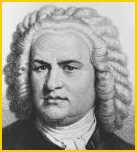
 |
| Our subscribers' grade-level estimate for this page: 3rd - 5th |
| A quiz on J. S. Bach | EnchantedLearning.com Johann Sebastian Bach: Baroque Composer |
Go to a printable version of this page |
 Johann Sebastian Bach (March 21, 1685-July 28, 1750) was a German Baroque composer. He was one of the greatest composers of all time, but during his lifetime, he was little-known and was mostly recognized for performing on the organ. Bach composed in many established musical forms, including, for example, the cantata and fugue, and developed them into complex and sublime pieces. He composed over 1,100 works in almost every musical genre (except opera).
Johann Sebastian Bach (March 21, 1685-July 28, 1750) was a German Baroque composer. He was one of the greatest composers of all time, but during his lifetime, he was little-known and was mostly recognized for performing on the organ. Bach composed in many established musical forms, including, for example, the cantata and fugue, and developed them into complex and sublime pieces. He composed over 1,100 works in almost every musical genre (except opera).
Bach was born and died in Germany, and spent his entire life there, working as an organist, teacher, and composer. He had over 20 children, including four who became famous musicians in their own right, including Carl Philipp Emanuel, Wilhelm Friedemann, Johann Christoph Friedrich, and Johann Christian.
Bach's Early Life:
Bach was the youngest of eight children. His father, Johann Ambrosius Bach, had been a town musician, and probably gave Bach his early music lessons. His mother, Maria Elisabetha, and his father died within a year of each other (in 1694 and 1695, respectively). Orphaned at age 10, Bach moved in with his an older brother, Johann Christoph, who was the organist at St. Michael's Church, Ohrdruf. This brother probably taught Bach much about the organ.
Bach's Early Career:
Bach's early career involved playing the violin and organ at a low-level position in the ruling court in Weimar and in Neukirche, Arnstadt, beginning in 1703.
Bach's First Marriage:
In October 1707, Bach married his cousin Maria Barbara Bach; together they would eventually have seven children (including Wilhelm Friedemann Bach
and Carl Philipp Emanuel Bach).
Life in Saxe-Weimar:
In 1708, Bach was appointed organist and chamber musician to the Duke of Saxe-Weimar. During the next nine years Bach composed many of his finest organ compositions, and became known as a fine organist.
During this period, Bach's major works included Toccata and Fugue in D Minor (1705), Cantata No. 208 (1713), and The Little Organ Book (1714).
Kapellmeister at Anhalt-Cothen:
In 1717, Bach became Kapellmeister (the chapel master, who directed and/or composed music for a church or chapel) in the court of the music-lover Prince Leopold of Anhalt-Cothen.
During this period, Bach's major works included the Brandenburg Concertos (1721), The Well-Tempered Clavier (first book, 1722). In 1721, the Prince married a woman who did not share the Prince's interest in music, and the Prince's support of Bach lessened. Bach would soon leave.
Bach's Second Marriage:
Bach's wife Maria had died in 1720. In 1721, he married Anna Magdalena Wilcke (the daughter of the town trumpeter); they would have 13 children together (including Johann Christian Bach). Altogether, Bach had 20 children with his two wives, but 10 of his children died in infancy. Four went on to become well-known composers and musicians.
Life in Leipzig:
Bach left Anhalt-Cothen in 1723 for Leipzig. He became Kantor (teacher and director of music) of St. Thomas's in Leipzig. Bach remained in Leipzig for the rest of his life.
During this period, Bach's major works included St. John Passion (1723), St. Matthew Passion (1727), Suite No. 3 in D (1729), Magnificat in D Major (1731), Christmas Oratorio (1734), Italian Concerto (1735), Goldberg Variations (1741-1742, originally called "Aria With Diverse Variations," but later nicknamed after Bach's student Johann Gottlieb Goldberg), The Well-Tempered Clavier (second book, 1742), the Musical Offering (1747), and The Art of the Fugue (unfinished, 1749).
Bach's Death:
By 1740, Bach's eyesight was failing. Two eye operations resulted in Bach's complete blindness; these operations also damaged his health and may have hastened his death. He died of a stroke on July 28, 1750. Bach is buried at St. John's cemetery, Leipzig. Bach's widow Anna lived for another ten years, dying in poverty in 1760. Bach's death in 1750 marked the end of the Baroque period in music.
The Re-Discovery of Bach's Works - Bach's Back:
Bach's works were soon forgotten (but then again, they were hardly known during his lifetime - many of his works were not published until a century after his death). In March, 1829 (almost 100 years after Bach's death), the composer Felix Mendelssohn performed Bach's St. Matthew Passion, spurring a world-wide interest in Bach. Soon, Bach's works were appreciated by the world - essentially for the first time.
Take a quiz on Johann Sebastian Bach.
| EnchantedLearning.com Music |
K-3 Music Theme Page |
| Musical Instruments |
Music Theory Printouts |
Sheet Music Printouts |
Composers | Music Calendar |
Enchanted Learning®
Over 35,000 Web Pages
Sample Pages for Prospective Subscribers, or click below
|
Overview of Site What's New Enchanted Learning Home Monthly Activity Calendar Books to Print Site Index K-3 Crafts K-3 Themes Little Explorers Picture dictionary PreK/K Activities Rebus Rhymes Stories Writing Cloze Activities Essay Topics Newspaper Writing Activities Parts of Speech Fiction The Test of Time
|
Biology Animal Printouts Biology Label Printouts Biomes Birds Butterflies Dinosaurs Food Chain Human Anatomy Mammals Plants Rainforests Sharks Whales Physical Sciences: K-12 Astronomy The Earth Geology Hurricanes Landforms Oceans Tsunami Volcano |
Languages Dutch French German Italian Japanese (Romaji) Portuguese Spanish Swedish Geography/History Explorers Flags Geography Inventors US History Other Topics Art and Artists Calendars College Finder Crafts Graphic Organizers Label Me! Printouts Math Music Word Wheels |
Click to read our Privacy Policy
| Search the Enchanted Learning website for: |
Copyright ©2001-2018 EnchantedLearning.com ------ How to cite a web page